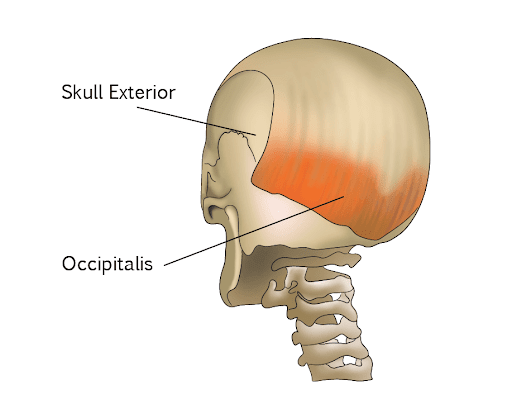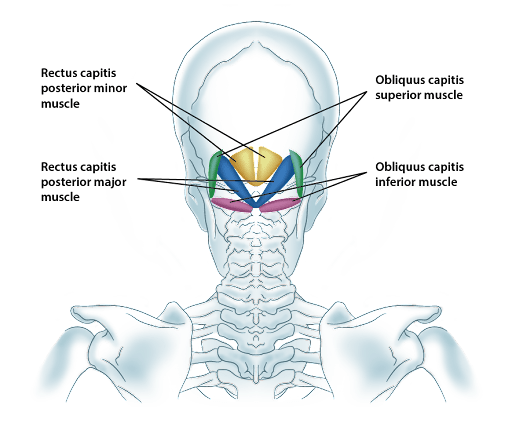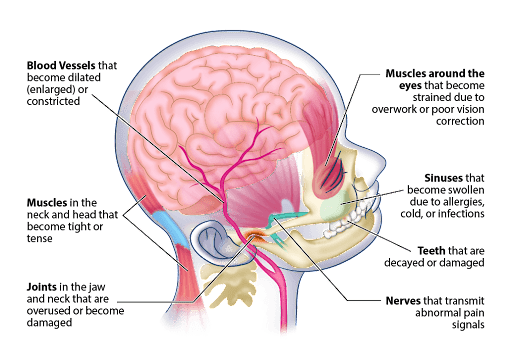Pain At The Base Of The Neck And Skull
Get Help With Pain At The Base Of The Neck And SkullPain at the base of the neck affects 30% of the population annually (1). However, only half of those affected by neck pain experience a complete resolution of their symptoms. In fact, some of these people develop chronic neck pain, which can affect everyday life and become debilitating.
There are many causes of pain at the base of the neck. As the neck houses vital structures like the carotid arteries, jugular veins, cervical spine, larynx, and esophagus, any base of the neck pain requires a thorough investigation. If you have neck pain, you have come to the right place to learn more about it.
Where In The Neck And Skull Does It Hurt?
The base of the skull is a complex area of the body. It houses the cervical spine, the facet joints of the vertebrae, connecting muscles, tendons, ligaments, and occipital and spinal nerves. Irritation or injury to any one of these structures can result in pain at the base of the skull.
Unfortunately, this area is not well understood by many health providers. As a result, this can lead to a delay in treatment and unnecessary pain and suffering. Here are a few places where your neck can hurt:
- Back Of The Head Towards The Neck
Pain at the base of the skull can radiate from the occiput or back of the skull down towards the neck due to the occipital nerves. All the occipital muscles and suboccipital muscles are responsible for the movement of the head, and include the rectus capitis posterior major, rectus capitis posterior minor, obliquus capitis inferior, and obliquus capitis superior.
Injury and inflammation of the cervical spine also lead to the base of the neck pain, as is seen in osteoarthritis, rheumatoid arthritis, and other inflammatory diseases.
- Back Of The Ears


Pain behind the ears can be caused by an injury to the structures located in the area, such as the occipitalis muscle, infections involving the ear, conditions of the temporomandibular joint (TMJ), inflammation of the greater and or lesser occipital nerves (occipital neuralgia), greater auricular nerve injury, and infection of the mastoid sinus. Injury, disease, or any other pathology involving these structured can lead to pain behind the ears.
- Side Of The Head And The Neck

Pain in the side of the neck is seen commonly in tension headaches, TMJ dysfunction, or inflammation of the temporal arteries. Additionally, when the muscles around the temporal region of the skull are strained, pain can radiate to the neck from the side of the skull, particularly over the temporal bone.
Types Of Pain At The Nape Of The Neck
Pain at the base of the skull can vary in type and intensity based on the cause of the pain. The pattern, sensation, and duration of pain can be characteristic of different conditions, so are often helpful in the diagnosis of these conditions.
For this reason, it’s a good idea to maintain a diary of the pain at the onset of pain. A pain diary is helpful as a doctor can review all the pain symptoms recorded and diagnose the cause based on the characteristics of the pain.
It is important to remember that any injury can result in sharp or throbbing pain, particularly when multiple structures at the base of the skull are injured. Some of the common types of this pain are listed below.
Dull, Throbbing, Or Aching Pain
Dull, throbbing, or aching pain is very common at the base of the skull and is initially observed in many conditions like high blood pressure, whiplash injuries, and accidents. These symptoms can fluctuate with movement and the position of the head.
Dull throbbing pain can also originate from tight or injured muscles, tendon injuries, osteoarthritis of the upper cervical spine, and joint problems.
Sharp Or Electric Pain
Sharp or electric pain is characteristic of neuralgia and neuropathies (which are conditions that affect the nerves). These conditions occur when the nerves are damaged and start misfiring, leading to shooting pain. The pain gets worse with time and is not relieved.
A Sensation Of Heaviness
Heaviness at the back of the neck or ears that gradually increases with time can indicate an infection or other inflammatory conditions. For example, ear infections, sinus infections, tension headaches, TMJ dysfunctions, and even migraines can cause a sensation of heavy-headedness.
It may also be accompanied by nausea and vomiting. Upper cervical joint and ligament instability can cause “heavy head” or “bobblehead” sensations, especially with more activity.
Causes Of Pain At The Base Of The Neck
There are many causes of neck pain, especially at the base of the skull. The occipital nerves are located at the base of the skull. Any condition that affects these nerves causes neck pain at the base of the skull.
Additionally, any condition involving the ligaments, tendons, and cervical spine can also cause pain at the back of the neck. Here are some causes of pain at the base of the skull and neck:
Muscle Tension Or Strain
Near the base of the skull are a group of muscles called the suboccipital muscles. Four paired muscles are attached as the sub occipitals to the upper two cervical bones (1). They connect the top two cervical vertebrae with the base of the skull.
The suboccipital muscles can become tense and tender due to factors such as eye strain, wearing new eyeglasses, poor ergonomics at a computer workstation, poor posture, or trauma. They can also be overworked due to compensating for ligament injury/instability. This can result in neck pain at the base of the skull.
Facet Joint Injury
Facet joint injuries commonly cause neck pain. A facet joint is a small, cartilage-lined joint that articulates between the vertebrae in the spine. The vertebrae of the cervical spine are numbered from 1-7.
For example, there is a right and left facet joint at C2/3 and at the C3/4 level, and so on until the base of the spine. The facet joint both guides and protects the motion of the spine. Facet joints are complex joints, so are susceptible to injury from degeneration, trauma, or surgery. Facet joint injury can lead to persistent neck pain at the base of the skull (2).
Disc Injury
A disc is the shock absorber that is sandwiched between each vertebrae in the spine. Like the facet joints, these intervertebral discs are susceptible to injury from degeneration, trauma, infection, surgery, and atlantoaxial instability due to lax ligaments of the upper vertebrae. Disc injuries can cause inflammation, restricted movement, and neck pain at the base of the skull (3).
Ligament Injury
Ligaments are thick bands of connective tissue that connect one bone to another. There are a large number of ligaments that provide stability to the neck, including the nuchal ligament, posterior atlantal occipital membrane, and supraspinous and interspinous ligaments (4).
Ligaments can be injured through trauma such as a motor vehicle accident or a fall. Additionally, certain connective tissue disorders such as hypermobility or Ehlers-Danlos syndrome can result in increased laxity in all of the ligaments. These conditions can affect other structures in the base of the spine and cause pain, such as the muscles, tendons, facet joints, discs, and nerves.
Nerve Irritation
The greater, lesser, and third occipital nerves originate in the upper cervical area and travel to the base of the skull. Unfortunately, these nerves can be compressed by tight neck muscles and fascia as they travel toward the base of the skull. Compression of these nerves can cause several symptoms including headache and neck pain at the base of the skull.
Atlantoaxial Instability (AAI)
Instability simply means that bones move around too much, usually due to damaged ligaments. In the spine, this can cause nerves to get banged into and joints to get damaged. In the craniocervical junction, instability can cause the upper cervical spinal nerves to get irritated, leading to headaches. In addition, the C0-C1 and C1-C2 facet joints can also get damaged. In addition, there are other nerves that exit the skull here that can get irritated, like the vagus nerve, which can cause rapid heart rate. What’s the Difference Between CCI and AAI? CCI refers to instability in any part of the craniocervical junction…
Read More About Atlantoaxial Instability (AAI)Cervical Medullary Syndrome
Cervical Medullary Syndrome is a clinical condition that occurs as a result of inflammation, deformity, or compression of the lower part of the brain. Symptoms can be extensive with fluctuating severity based upon the extent of the underlying injury. For example, mild irritation of the brainstem may cause only mild, intermittent symptoms. The upper cervical spine and brain are complex with multiple structures. These structures reside within the skull and protective confines of the cervical spine. Neither expands to accommodate inflammation, injury, and disease. Rather the delicate tissues of the brain and spinal cord are irritated or compressed. The 4 major conditions that cause cervical medullary syndrome are…
Read More About Cervical Medullary SyndromeChiari Malformation
Chiari Malformation Is a medical condition where a part of the brain at the back of the skull abnormally descends through an opening in the skull. It is named after Dr. Hans Chiari who was an Austrian pathologist who in the late 1880’s studied deformities of the brain.The brain is a large structure divided into different parts that reside within the skull. Important parts of the brain called the Cerebellum and Brainstem sit at the base of the skull. The Foramen Magnum is a large hole at the base of the skull that allows the brain to join the spinal canal. The Cerebellum…
Read More About Chiari MalformationCraniocervical Instability
Craniocervical Instability is a medical condition characterized by injury and instability of the ligaments that hold your head onto the neck. Common symptoms of Cranial Cervical Instability include a painful, heavy head, headache, rapid heart rate, brain fog, neck pain, visual problems, dizziness, and chronic fatigue.CCI or neck ligament laxity treatment options depend upon the severity of the instability and clinical symptoms. When appropriate, conservative care should always be the first-line treatment. Craniocervical Instability Surgery is often recommended when conservative care fails. This involves a fusion of the head to the neck which is a major surgery that is associated with significant risks and complications…
Read More About Craniocervical InstabilityRelief For Neck Pain
- There are many treatment options for neck pain at the base of the skull. We have compared the pros and cons of each of them below:
Physical Therapy
Pros:
• Physical therapy is recommended as a first-line treatment
• Reduces muscle stiffness
• Relaxes the muscles of the head and neck
• Can strengthen weak muscles
• May help with pain
Cons:
• Physical therapy is supportive only and can strengthen weak muscles, but not treat torn muscles or ligaments
• Takes a while to have an effect
• Sometimes can cause neck pain flare up - Chiropractic care
Pros:
• Specific upper cervical chiropractic care such as Atlas Orthogonal, NUCCA, Blair can help cervical alignment and reduce symptoms
Cons:
• May only provide temporary relief
• Doesn’t heal injured structures - Steroids
Pros:
• Can provide immediate pain relief
• Reduces inflammation
Cons:
• Cannot be used long term
• Reduces immunity
• Can lead to bone loss and osteoporosis
• Reduces healing
• Has many potential systemic side effects
• Does not help injured structures - Non-Steroidal Anti-Inflammatory Drugs (NSAIDs)
Pros
• Readily available over the counter
• Provides immediate relief
• Reduces pain and inflammation
• Can also be applied topically for pain relief
Cons
• Causes gastrointestinal ulcers
• Can decrease kidney and liver function if taken over an extended period at high doses
• Can increase the risk of heart attack and stroke
• Can inhibit healing
• Does not help injured structures - Narcotics
Pros
• Provides immediate pain relief, especially for pain that is not relieved by NSAIDs
• May be effective for some chronic pain
Cons
• Can lead to physical and psychological dependence
• Can develop tolerance to the medications, thus requiring increasingly higher doses over time relief
• Requires close supervision
• Overdose can cause respiratory depression or death
• Does not help injured structures
Traditional medical interventions are used to treat the base of the skull pain and they work for most patients. However, they are not recommended for everyone. Individuals with other pre-existing conditions like heart disease, renal disease, bone disease, and other chronic conditions cannot use them.
Additionally, narcotics and painkillers can become highly addictive if they are not carefully monitored by a medical practitioner. They also have a myriad of side effects that make them less than ideal for treating chronic pain.
Combination therapy is therefore usually best for these patients. Patients can try a combination of conservative management with advanced therapies for long-term pain relief.
The Consequences Of Not Treating Back Of Neck Pain
If you have been experiencing pain in the back of the neck, then you should seek medical help. A health professional can assess your symptoms and use a tailored treatment approach to address the root cause of the problem. Early diagnosis is the key for good outcomes as it can allow for prompt treatment.
However, when left untreated, pain at the base of your skull can get worse over time. The diagnosis process can also rule out more serious causes of lower head and neck pain, such as high blood pressure, subacute brain bleeding, or a tumor.
Self-medicating with pain relievers may relieve the pain but will not address the root cause. If you do not diagnose and treat back of the neck pain, you might experience the following symptoms:
Advanced Medical Treatment Options
Treatment options depend upon the underlying cause of the pain. Conservative therapy in the form of physical therapy (when appropriate) is the best first-line treatment.
Steroids are often recommended by medical practitioners but should be avoided where possible as they have significant side effects. NSAIDs are also recommended, but as with most medications carry a significant risk when not used appropriately.
Additionally, medications like narcotics have a high risk of drug dependence.
At the Centeno-Schultz Clinic, we offer a range of treatment options for specific and chronic pain symptoms in the back of the neck and base of the skull. These options are designed to work with the body’s growth factors, thereby minimizing the need for costly surgery or potentially fatal steroids.
Our treatment options include Platelet-rich plasma (PRP) and bone marrow concentrate containing stem cells. We pioneered the only nonsurgical treatment for upper cervical ligament injuries.
We have the most experienced physicians in the U.S. who have performed over a thousand procedures on the C0-C2 area of the cervical spine. Many doctors offer PRP and stem cell injections to the cervical spine, but they do not inject all the important structures such as the upper cervical facet joints and the deep posterior ligaments.
Additionally, Dr Centeno and Dr Schulz have devised a novel way to introduce these cells from the front, thus ensuring that the anterior ligaments are treated as well. This is a first-of-its-kind procedure that has a wide range of benefits. Our doctors will review your situation carefully to determine if you are a suitable candidate for this surgery, and the amazing results that come with it.
To learn more about ligament injuries in the neck and treatment options please click on the video below.
Stop The Pain And Suffering Today
Neck pain at the base of the skull can be debilitating. The wrong diagnosis can lead to painful consequences that can affect your health and way of life. There are various non-surgical treatment options for chronic pain at the base of the skull at Centeno-Schultz. With the right treatment from a certified physician, the pain can be managed and further injury can be prevented.
If you or a loved one suffer from neck pain at the base of the skull, please schedule a telemedicine or in-person appointment with a physician at our Centeno-Schultz Clinic. We are all board-certified, fellowship-trained practitioners with expertise in neck pain and regenerative treatment options.
Our Centeno-Schultz Clinic offers virtual consultations for head, neck, and back pain.
References
- Goode AP, Freburger J, Carey T. Prevalence, practice patterns, and evidence for chronic neck pain. Arthritis Care Res (Hoboken). 2010 Nov;62(11):1594-601. doi: 10.1002/acr.20270. Epub 2010 Jun 2. PMID: 20521306; PMCID: PMC2974793.
